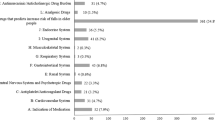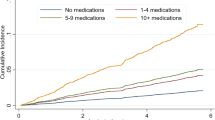Abstract
Background
There is strong evidence that potentially inappropriate prescribing is associated with falls in older adults. Fall-related hospitalizations should trigger medication review.
Objectives
The aim of this before-and-after cohort study was to explore patterns of relevant potentially inappropriate prescribing in older people with fall-related hospitalizations.
Methods
Data on older adults with hospitalizations for falls, fractures and syncope between 2012 and 2016 were collected from 44 general practices in Ireland. Fall-related prescribing was defined from the Screening Tool for Older Persons’ Prescriptions (sedatives and vasodilators) and the Screening Tool to Alert doctors to Right Treatment (vitamin D). Prevalence of prescriptions were estimated from general practice and hospital discharge records. Mixed-effects logistic regression was conducted to compare the 12-month pre- and post-hospitalization periods.
Results
Overall, 927 individuals (68% female, average age 81.2 years; standard deviation 8.6) were included, 45% of whom had a diagnosis of fracture, 28% had syncope, and 27% had a fall without fracture/syncope. After adjustment for covariates and practice clustering effects, both vitamin D and sedatives had higher odds of prescription post-hospitalization (adjusted odds ratio [aOR] 4.47, 95% confidence interval [CI] 2.09–9.54, and aOR 1.75, 95% CI 1.29–2.39, respectively). With adjustments for age and sex, having a fracture was associated with new initiation of vitamin D (aOR 2.81, 95% CI 1.76–4.46) and having syncope was associated with continuing on vasodilators (aOR 1.99, 95% CI 1.06–3.74). No factors were associated with new sedative initiation.
Conclusion
Fall-related potentially inappropriate prescribing is prevalent in older adults who have a history of falls, and continues after discharge from hospital. Future studies should investigate why such prescribing is initiated after a fall-related hospitalization, and explore interventions that could reduce such hazardous prescribing.


Similar content being viewed by others
References
National Office of Clinical Audit. Major trauma audit national report 2016. Dublin: 2018. https://www.noca.ie/publications. Accessed 10 Oct 2018.
Kehoe A, Smith JE, Edwards A, Yates D, Lecky F. The changing face of major trauma in the UK. Emerg Med J. 2015;32:911–5.
Morrison A, Fan T, Sen SS, Weisenfluh L. Epidemiology of falls and osteoporotic fractures: a systematic review. Clinicoecon Outcomes Res. 2013;5:9–18.
Close JC, Lord SR, Antonova EJ, Martin M, Lensberg B, Taylor M, et al. Older people presenting to the emergency department after a fall: a population with substantial recurrent healthcare use. Emerg Med J. 2012;29:742–7.
National Institute for Health and Care Excellence. Falls In older people: assessing risk and prevention. CG161. London: National Institute for Health and Care Excellence; 2013.
Grossman DC, Curry SJ, Owens DK, Barry MJ, Caughey AB, Davidson KW, et al. Interventions to prevent falls in community-dwelling older adults: US preventive services task force recommendation statement. JAMA. 2018;319:1696–704.
Woolcott JC, Richardson KJ, Wiens MO, Patel B, Marin J, Khan KM, et al. Meta-analysis of the impact of 9 medication classes on falls in elderly persons. Arch Intern Med. 2009;169:1952–60.
Seppala LJ, Wermelink A, de Vries M, Ploegmakers KJ, van de Glind EMM, Daams JG, et al. Fall-risk-increasing drugs: a systematic review and meta-analysis: II. Psychotropics. J Am Med Dir Assoc. 2018;19:371.e11–7.
American Geriatrics Society 2015 Beers Criteria Update Expert Panel. American Geriatrics Society. updated Beers criteria for potentially inappropriate medication use in older adults. J Am Geriatr Soc. 2015;2015(63):2227–46.
O’Mahony D, O’Sullivan D, Byrne S, O’Connor MN, Ryan C, Gallagher P. STOPP/START criteria for potentially inappropriate prescribing in older people: version 2. Age Ageing. 2015;44:213–8.
de Vries M, Seppala LJ, Daams JG, van de Glind EMM, Masud T, van der Velde N. Fall-risk-increasing drugs: a systematic review and meta-analysis: I. Cardiovascular drugs. J Am Med Dir Assoc. 2018;19:371–9.
Compston J, Cooper A, Cooper C, Gittoes N, Gregson C, Harvey N, et al. UK clinical guideline for the prevention and treatment of osteoporosis. Arch Osteoporos. 2017;12:43.
Gallagher P, Ryan C, Byrne S, Kennedy J, O'Mahony D. STOPP (Screening Tool of Older Person’s Prescriptions) and START (Screening Tool to Alert doctors to Right Treatment). Consensus validation. Int J Clin Pharmacol Ther. 2008;46:72–83.
Gallagher P, Baeyens JP, Topinkova E, Madlova P, Cherubini A, Gasperini B, et al. Inter-rater reliability of STOPP (Screening Tool of Older Persons’ Prescriptions) and START (Screening Tool to Alert doctors to Right Treatment) criteria amongst physicians in six European countries. Age Ageing. 2009;38:603–6.
Hill-Taylor B, Sketris IS, Gardner DM, Thompson K. Concordance with a STOPP (Screening Tool Of Older Persons’ Potentially Inappropriate Prescriptions) criterion in Nova Scotia, Canada: benzodiazepine and zoplicone prescription claims by older adults with fall-related hospitalizations. J Popul Ther Clin Pharmacol. 2016;23:e1–12.
McMahon CG, Cahir CA, Kenny RA, Bennett K. Inappropriate prescribing in older fallers presenting to an Irish emergency department. Age Ageing. 2014;43:44–50.
Pérez T, Moriarty F, Wallace E, McDowell R, Redmond P, Fahey T. Prevalence of potentially inappropriate prescribing in older people in primary care and its association with hospital admission: longitudinal study. BMJ. 2018;363:k4524.
von Elm E, Altman DG, Egger M, Pocock SJ, Gotzsche PC, Vandenbroucke JP. The Strengthening the Reporting of Observational Studies in Epidemiology (STROBE) statement: guidelines for reporting observational studies. Int J Surg. 2014;12:1495–9.
Sweeney J, Kearney P, Redmond P, Fahey T. Point of care morbidity coding; a feasibility study in primary care. Forum J Irish Coll Gen Pract. 2017;34:52–4.
National Centre for Classification in Health. The International Statistical Classification of Diseases and Related Health Problems, Tenth Revision, Australian Modification (ICD-10-AM). Sydney: The University of Sydney; 1998.
Nauta KJ, Groenhof F, Schuling J, Hugtenburg JG, van Hout HPJ, Haaijer-Ruskamp FM, et al. Application of the STOPP/START criteria to a medical record database. Pharmacoepidemiol Drug Saf. 2017;26:1242–7.
de Groot DA, de Vries M, Joling KJ, van Campen JP, Hugtenburg JG, van Marum RJ, et al. Specifying ICD9, ICPC and ATC codes for the STOPP/START criteria: a multidisciplinary consensus panel. Age Ageing. 2014;43:773–8.
WHO Collaborating Centre for Drug Statistics Methodology. ATC/DDD Index. 2015. http://www.whocc.no/atc_ddd_index/. Accessed 13 Jul 2015.
Gillespie LD, Robertson MC, Gillespie WJ, Sherrington C, Gates S, Clemson LM, et al. Interventions for preventing falls in older people living in the community. Cochrane Database Syst Rev. 2012;2:CD007146.
Reeve E, Moriarty F, Nahas R, Turner JP, Kouladjian O’Donnell L, Hilmer SN. A narrative review of the safety concerns of deprescribing in older adults and strategies to mitigate potential harms. Expert Opin Drug Saf. 2018;17:39–49.
Boye ND, van der Velde N, de Vries OJ, van Lieshout EM, Hartholt KA, Mattace-Raso FU, et al. Effectiveness of medication withdrawal in older fallers: results from the Improving Medication Prescribing to reduce Risk Of FALLs (IMPROveFALL) trial. Age Ageing. 2017;46:142–6.
Eckstrom E, Parker EM, Lambert GH, Winkler G, Dowler D, Casey CM. Implementing STEADI in academic primary care to address older adult fall risk. Innov Aging. 2017;1:igx028.
Mott DA, Martin B, Breslow R, Michaels B, Kirchner J, Mahoney J, et al. Impact of a medication therapy management intervention targeting medications associated with falling: results of a pilot study. J Am Pharm Assoc. 2016;56:22–8.
Lasserre A, Younes N, Blanchon T, Cantegreil-Kallen I, Passerieux C, Thomas G, et al. Psychotropic drug use among older people in general practice: discrepancies between opinion and practice. Br J Gen Pract. 2010;60:e156–62.
Gould RL, Coulson MC, Patel N, Highton-Williamson E, Howard RJ. Interventions for reducing benzodiazepine use in older people: meta-analysis of randomised controlled trials. Br J Psychiatry. 2014;204:98–107.
Bell HT, Steinsbekk A, Granas AG. Factors influencing prescribing of fall-risk-increasing drugs to the elderly: a qualitative study. Scand J Prim Health Care. 2015;33:107–14.
Visschedijk J, Achterberg W, van Balen R, Hertogh C. Fear of falling after hip fracture: a systematic review of measurement instruments, prevalence, interventions, and related factors. J Am Geriatr Soc. 2010;58:1739–48.
Zijlstra GAR, Van Haastregt JCM, Van Rossum E, Van Eijk JTM, Yardley L, Kempen GIJM. Interventions to reduce fear of falling in community-living older people: a systematic review. J Am Geriatr Soc. 2007;55:603–15.
Zhao JG, Zeng XT, Wang J, Liu L. Association between calcium or vitamin D supplementation and fracture incidence in community-dwelling older adults: a systematic review and meta-analysis. JAMA. 2017;318:2466–82.
Bolland MJ, Grey A, Avenell A. Effects of vitamin D supplementation on musculoskeletal health: a systematic review, meta-analysis, and trial sequential analysis. Lancet Diabetes Endocrinol. 2018;6(11):847–58.
Laird E, O’Halloran AM, Carey D, Healy M, O’Connor D, Moore P, et al. The prevalence of vitamin D deficiency and the determinants of 25(OH)D concentration in older irish adults: data from The Irish Longitudinal Study on Ageing (TILDA). J Gerontol A Biol Sci Med Sci. 2018;73:519–25.
Gallacher SJ, McQuillian C, Harkness M, Finlay F, Gallagher AP, Dixon T. Prevalence of vitamin D inadequacy in Scottish adults with non-vertebral fragility fractures. Curr Med Res Opin. 2005;21:1355–61.
Petrella RJ, Jones TJ. Do patients receive recommended treatment of osteoporosis following hip fracture in primary care? BMC Fam Pract. 2006;7:31.
Bromfield SG, Ngameni CA, Colantonio LD, Bowling CB, Shimbo D, Reynolds K, et al. Blood pressure, antihypertensive polypharmacy, frailty, and risk for serious fall injuries among older treated adults with hypertension. Hypertension. 2017;70:259–66.
National Office of Clinical Audit. Irish Hip Fracture Database National Report 2017. Dublin: 2018. https://www.noca.ie/publications. Accessed 10 Jan 2019.
Grimes T, Duggan C, Delaney T. Pharmacy services at admission and discharge in adult, acute, public hospitals in Ireland. Int J Pharm Pract. 2010;18:346–52.
Lee DC, McDermott F, Hoffmann T, Haines TP. ‘They will tell me if there is a problem’: limited discussion between health professionals, older adults and their caregivers on falls prevention during and after hospitalization. Health Educ Res. 2013;28:1051–66.
Health Services Executive. Making a start in integrated care for older persons. Dublin: Health Services Executive; 2017.
Renom-Guiteras A, Thurmann PA, Miralles R, Klaassen-Mielke R, Thiem U, Stephan A, et al. Potentially inappropriate medication among people with dementia in eight European countries. Age Ageing. 2018;47:68–74.
Bischoff-Ferrari HA, Dawson-Hughes B, Orav EJ, Staehelin HB, Meyer OW, Theiler R, et al. Monthly high-dose vitamin D treatment for the prevention of functional decline: a randomized clinical trial. JAMA Intern Med. 2016;176:175–83.
Ryan C, O’Mahony D, Kennedy J, Weedle P, Byrne S. Potentially inappropriate prescribing in an Irish elderly population in primary care. Br J Clin Pharmacol. 2009;68:936–47.
Seppala LJ, van de Glind EMM, Daams JG, Ploegmakers KJ, de Vries M, Wermelink A, et al. Fall-risk-increasing drugs: a systematic review and meta-analysis: II. Others. J Am Med Dir Assoc. 2018;19:3721–8.
Acknowledgements
The authors gratefully acknowledge the contributions of all participating general practitioners and patients.
Author information
Authors and Affiliations
Corresponding author
Ethics declarations
Funding
This study was funded by the Health Research Board (HRB) in Ireland through Grant no. HRC/2014/1 (TF).
Conflicts of interest
Mary E. Walsh, Fiona Boland, Frank Moriarty and Tom Fahey declare that they have no conflicts of interest.
Ethical approval
All procedures performed in this study were in accordance with the ethical standards of the institutional and/or national research committee and with the 1964 Helsinki declaration and its later amendments or comparable ethical standards. For this type of study, formal consent is not required.
Electronic supplementary material
Below is the link to the electronic supplementary material.
Rights and permissions
About this article
Cite this article
Walsh, M.E., Boland, F., Moriarty, F. et al. Modification of Potentially Inappropriate Prescribing Following Fall-Related Hospitalizations in Older Adults. Drugs Aging 36, 461–470 (2019). https://doi.org/10.1007/s40266-019-00646-z
Published:
Issue Date:
DOI: https://doi.org/10.1007/s40266-019-00646-z




